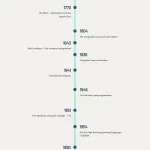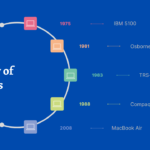Laravel has established itself as a dominant force in the PHP web development world. Its focus on developer experience and a regular release cycle keeps it at the forefront of innovation. But with so many versions released over the years, keeping track of timelines and support lifecycles can be tricky.
This article provides a developer-centric breakdown of Laravel versions, highlighting release dates and key features.
-
June 1, 2011Laravel 1Laravel 1 marked the introduction of a basic MVC (Model-View-Controller) architecture. Created by Taylor Otwell, Laravel aimed to offer a more advanced alternative to the CodeIgniter framework, which lacked built-in support for essential features like user authentication and authorization.
-
September 1, 2011Laravel 2Laravel 2 introduced significant enhancements including support for controllers, an Inversion of Control (IoC) container, and improved routing mechanisms. These features provided developers with greater flexibility and modularity in their applications. However, Laravel 2 also saw the removal of support for third-party packages, which was a notable downside.
-
February 22, 2012Laravel 3Laravel 3 introduced an array of powerful features that significantly enhanced developer productivity and framework flexibility. Notable additions included Artisan, a robust command-line interface (CLI) that streamlined various development tasks, and built-in support for an expanded range of database management systems.
Laravel 3 also introduced database migrations, providing a robust version control system for database schemas, and event handling capabilities, which simplified event-driven programming. Additionally, the introduction of Bundles, a modular packaging system, facilitated code reuse and distribution.
These innovations contributed to a surge in Laravel’s popularity and a growing user base, cementing its position as a leading PHP framework. -
May 28, 2013Laravel 4Laravel 4, codenamed Illuminate, was released in May 2013 and marked a significant overhaul from its predecessors. This version introduced Composer for efficient dependency management, making it easier to handle package installations and updates.
The Eloquent ORM saw notable improvements, enhancing database interactions and streamlining complex queries. This version also included database seeding for initial data population, support for message queues, built-in email sending capabilities, and the soft deletion feature for delayed removal of database records, providing developers with a comprehensive and flexible framework.
Laravel 4 also brought robust support for RESTful controllers, facilitating the development of RESTful APIs. -
February 4, 2015Laravel 5
Laravel 5 marked a significant evolution in the framework’s development. It introduced several key features that enhanced its functionality and flexibility. Among these were the addition of support for Middleware, which provided a convenient way to filter HTTP requests entering the application.
It also integrated Flysystem for seamless cloud storage operations, allowing developers to interact with various storage systems using a unified API.
Laravel 5 brought a revamped directory structure, aimed at improving the organization and readability of code.
This release was essentially a renumbering of what was initially intended to be Laravel 4.3, reflecting the substantial internal changes and enhancements made to the framework.Laravel Version Release Date Key Features Laravel 5.1 June 2015 First LTS (Long Term Support) version, added support for Event Broadcasting, improved handling of authentication and authorization. Laravel 5.2 December 2015 Introduced simplified global scopes, implicit model binding, and array validation. Laravel 5.3 August 2016 Added Laravel Echo, improved Blade components and slots, and introduced notifications. Laravel 5.4 January 2017 Improved Blade templating engine, added Laravel Dusk for browser testing, and Markdown-based email rendering. Laravel 5.5 August 2017 LTS version, introduced package auto-discovery, and added new frontend presets. Laravel 5.6 February 2018 Logging improvements, single server task scheduling, and improved Blade components. Laravel 5.7 September 2018 Added email verification, new console testing capabilities, and improved resources directory structure. Laravel 5.8 February 2019 Cache TTL changes, automatic policy resolution, and improved artisan serve. -
September 3, 2019Laravel 6This version incorporated shift blueprint code generation, making it easier for developers to generate and maintain their database schema. It also adopted semantic versioning, ensuring more predictable and structured updates.
Compatibility with Laravel Vapor was another highlight, enabling seamless deployment and scaling on serverless infrastructure. Laravel 6 improved authorization responses and introduced job middleware for more efficient task handling.
Lazy collections were added for optimized memory usage, and sub-query improvements enhanced query performance. Notably, frontend scaffolding was decoupled from the main package and moved to the laravel/ui package, promoting a more modular approach. -
March 3, 2020Laravel 7Laravel 7, released on March 3, 2020, brought a range of powerful new features to the framework. One of the standout additions was Laravel Sanctum, which provides a lightweight authentication system for SPAs (Single Page Applications), mobile applications, and simple token-based APIs. The update also introduced Custom Eloquent Casts, allowing developers to define custom cast types for their models.
Blade Component Tags were added to improve the flexibility and readability of Blade templates. Fluent String Operations provided a more expressive and convenient way to manipulate strings.
Route Model Binding Improvements enhanced the ease of routing by allowing developers to automatically inject model instances into their routes, streamlining the development process. -
September 8, 2020Laravel 8Among the standout additions is Laravel Jetstream, a robust application starter kit that streamlines the process of setting up authentication and other common features. The introduction of model factory classes provides a more intuitive way to generate test data, while migration squashing helps keep the migration files organized and reduces clutter by allowing multiple migration files to be consolidated into a single SQL file.
Laravel 8 integrates Tailwind CSS for pagination views, offering a modern, responsive design out of the box. These updates, along with various usability improvements, make Laravel 8 a powerful and user-friendly framework for web development. -
February 8, 2022Laravel 9Laravel 9 brings a host of enhancements building on the solid foundation of Laravel 8.x. Key updates include the integration of Symfony 6.0 components and Symfony Mailer, which streamline email handling. The upgrade to Flysystem 3.0 improves file storage capabilities, and the new database driver for Laravel Scout enhances search functionalities.
-
February 14, 2023Laravel 10Laravel 10 introduces several exciting features and improvements, enhancing both development efficiency and performance. One notable addition is Laravel Pennant, a first-party package for managing feature flags, allowing developers to easily toggle features on and off. Handling external processes has become more streamlined, making it simpler to manage and execute tasks outside the application.
Performance-wise, Laravel 10 aids in identifying slow-running tests, ensuring faster feedback during development. By default, invokable validation rules are now used, promoting cleaner and more maintainable code. The framework’s skeleton and first-party packages have adopted native types, moving away from docblocks, which leads to better type safety and autocompletion in modern IDEs.
Developers can now customize the path of config files, providing more flexibility in organizing project configurations. -
March 12, 2024Laravel 11Laravel 11 brings significant advancements for developers, enhancing both performance and security. With improved routing and caching mechanisms, applications run faster and more efficiently. The framework includes new developer tools and a simplified upgrade process, ensuring a smooth transition and ease of use. Full compatibility with PHP 8.2 guarantees modern standards are met.
The project structure has been streamlined, reducing the number of preset directories and centralizing configuration settings into .env files for better manageability. Enhanced data handling and middleware management, along with improved scheduling and bug-fixing tools, make development more seamless.
Optimizations in route organization and model relations, advanced rate limiting, and the addition of a new health check endpoint further solidify Laravel 11 as a robust framework for modern web development.





